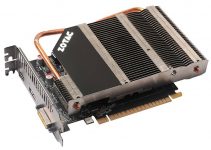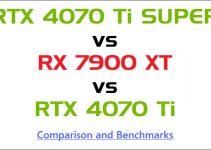Just a few days after the release of Nvidia’s flagship GeForce RTX 5090, Nvidia launched the GeForce RTX 5080, the second card in the GeForce RTX 50 Series. RTX 5080 is a more affordable solution and costs half of the RTX 5090. Even though the technical specifications of RTX 5080 are almost half of RTX 5090, RTX 5080 still packs a punch and is a very powerful card for 4K gaming. Let us find out how the RTX 5080 compares against its predecessor RTX 4080 SUPER and AMD’s flagship RX 7900 XTX on important parameters, including performance.
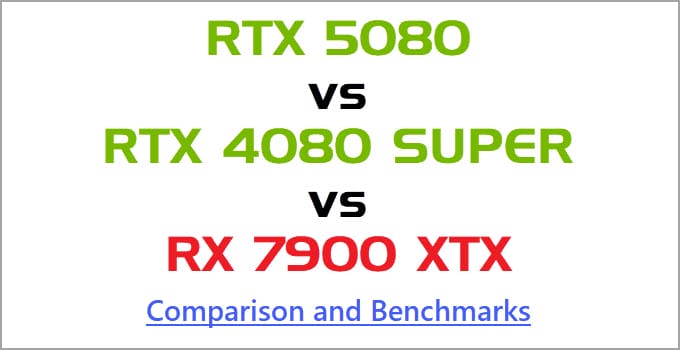
RTX 5080 vs RX 7900 XTX vs RTX 4080 SUPER Comparison
A quick comparison between RTX 5080, RTX 4080 SUPER, and RX 7900 XTX graphics cards based on their specifications, gaming performance, pricing, power consumption, and features.
GPU Architecture
GeForce RTX 5080 is built on Nvidia’s latest Blackwell GPU architecture on a 5nm manufacturing process. It uses GB203 GPU chip and has 10752 CUDA Cores, 84 RT Cores (4th Generation), and 336 Tensor Cores (5th Generation). On the other hand, RTX 4080 SUPER is built on the Ada Lovelace GPU architecture with a 5nm manufacturing process. It uses AD103 GPU chip and has 9725 CUDA Cores, 76 RT Cores (3rd Generation), and 304 Tensor Cores (4th Generation)
Radeon RX 7900 XTX is built on RDNA 3 GPU architecture. It uses a Chiplet design where the GPU package consists of a Graphics Compute Die (GCD) and multiple Memory Cache Dies (MCD) surrounding the GCD. The GCD is built on a 5nm fabrication process, while the MCD is built on a 6nm manufacturing process. The card uses Navi 31 GPU chip and has 6144 Stream Processors, 96 Ray Accelerators, and 192 AI Accelerators.
Must Read: CUDA Cores vs Stream Processors
| RTX 5080 | RX 7900 XTX | RTX 4080 SUPER | |
| GPU Chip | GB203 | Navi 31 | AD103 |
| GPU Architecture | Blackwell | RDNA 3 | Ada Lovelace |
| Fabrication Process | 5nm | 5nm | 5nm |
| CUDA Cores/Stream Processors | 10752 CUDA Cores | 6144 Stream Processors | 9725 CUDA Cores |
| RT Cores | 84 (4th Generation) | 96 | 76 (3rd Generation) |
| Tensor Cores / | 336 (5th Generation) | 192 | 304 (4th Generation) |
Video RAM [VRAM]
RTX 5080 comes with 16 GB GDDR7 memory with a 256-bit interface. The memory runs at a speed of 30 Gbps and delivers a bandwidth of 960 GB/s. RX 7900 XT has 24 GB GDDR6 memory with a 384-bit interface and runs at 20 Gbps, generating bandwidth of 960 GB/s. RX 7900 XTX also comes equipped with 96MB Infinity Cache, an ultra-fast memory cache that can boost peak memory bandwidth to up to 3500 GB/s. RTX 4080 SUPER comes with 16 GB GDDR6X memory with a 256-bit interface and speed of 22.4. The memory bandwidth generated is 717 GB/s.
| RTX 5080 | RX 7900 XTX | RTX 4080 SUPER | |
| Memory Size | 16 GB GDDR7 | 24 GB GDDR6 | 16 GB GDDR6X |
| Memory Interface | 256-bit | 384-bit | 256-bit |
| Memory Speed | 30 Gbps | 20 Gbps | 22.4 Gbps |
| Memory Bandwidth | 960 GB/s | 960 GB/s | 717 GB/s |
| Infinity Cache | NA | 96 MB | NA |
Features
All three graphics cards are VR-ready and support DirectX 12, OpenGL 4.6, Vulkan, AV1 Encode/Decode, Real-Time Ray Tracing, and variable refresh rate technologies G-Sync/FreeSync. RTX 5080 supports PCIe 5.0 while RTX 4080 SUPER and RX 7900 XTX support PCIe 4.0 interface. Regarding image upscaling technologies for increasing frame rate in games, RTX 5080 supports DLSS 4, RTX 4080 SUPER supports DLSS 3, while RX 7900 XTX supports AMD FidelityFX Super Resolution (FSR 3). Regarding video output ports, RTX 5080 supports DisplayPort 2.1b and HDMI 2.1b, RX 7900 XTX supports DisplayPort 2.1a and HDMI 2.1a, while RTX 4080 SUPER supports HDMI 2.1a but does not support DisplayPort 2.1.
| RTX 5080 | RX 7900 XTX | RTX 4080 SUPER | |
| Bus Interface | PCI Express 5.0 | PCI Express 4.0 | PCI Express 4.0 |
| DirectX | 12 Ultimate | 12 Ultimate | 12 Ultimate |
| OpenGL | 4.6 | 4.6 | 4.6 |
| Vulkan | 1.4 | 1.3 | 1.3 |
| SLI / CrossFire | NA | NA | NA |
| VR Ready | Yes | Yes | Yes |
| G-Sync/FreeSync | Yes | Yes | Yes |
| HDMI 2.1 | Yes (HDMI 2.1b) | Yes (HDMI 2.1a) | Yes (HDMI 2.1a) |
| DisplayPort 2.1 | Yes (DisplayPort 2.1b) | Yes (DisplayPort 2.1a) | No |
| AV1 Support (Encode/Decode) | Yes | Yes | Yes |
| Real-Time Ray Tracing | Yes | Yes | Yes |
| Deep Learning Super Sampling (DLSS) | Yes (DLSS 4) | NA | Yes (DLSS 3) |
| FidelityFX Super Resolution (FSR) | NA | FSR 2 | NA |
Gaming Performance
Here are the gaming benchmarks of these cards at 1440p and 4K resolution in various latest AAA games.
1440p Gaming Benchmarks
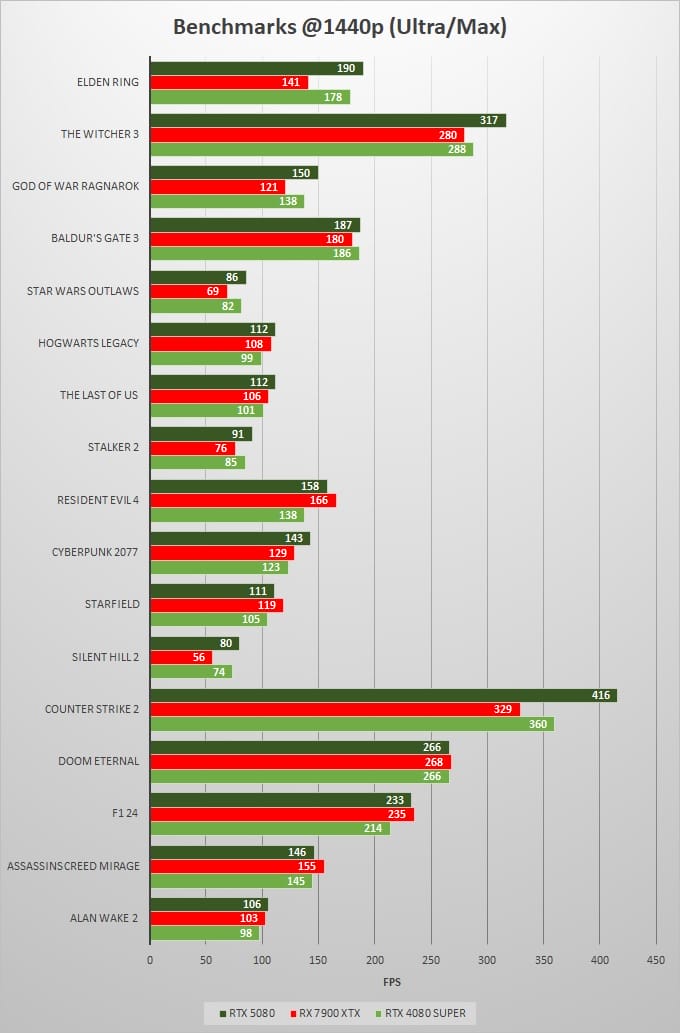
4K Gaming Benchmarks
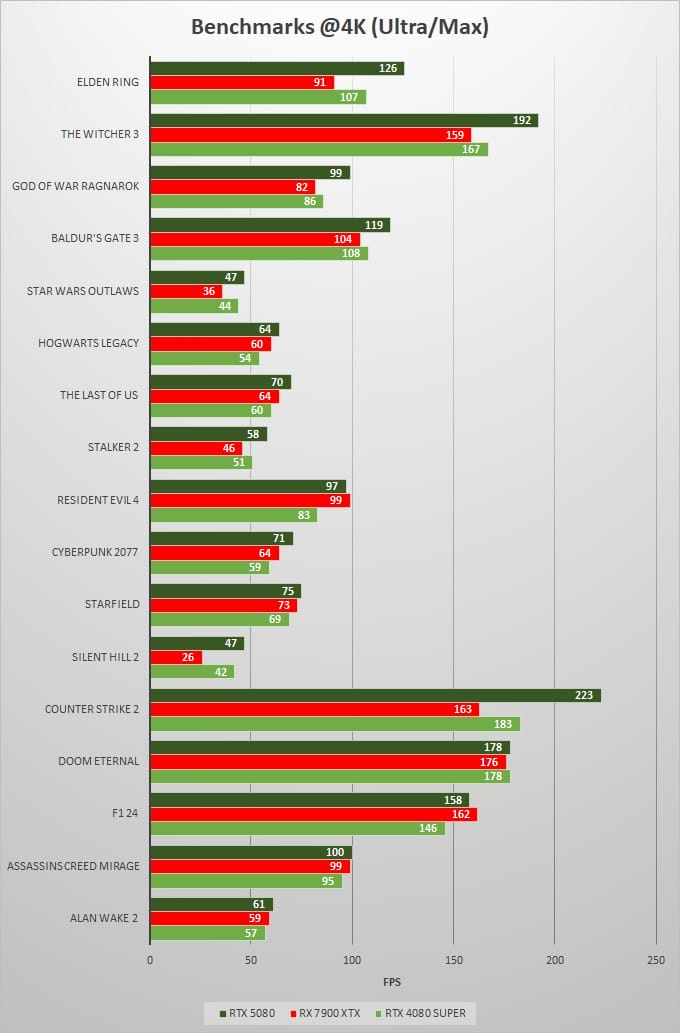
From the above gaming benchmarks, RTX 5080 is, on average, 10 percent faster than RTX 4080 SUPER and 12 percent faster than RX 7900 XTX.
Ray Tracing Performance
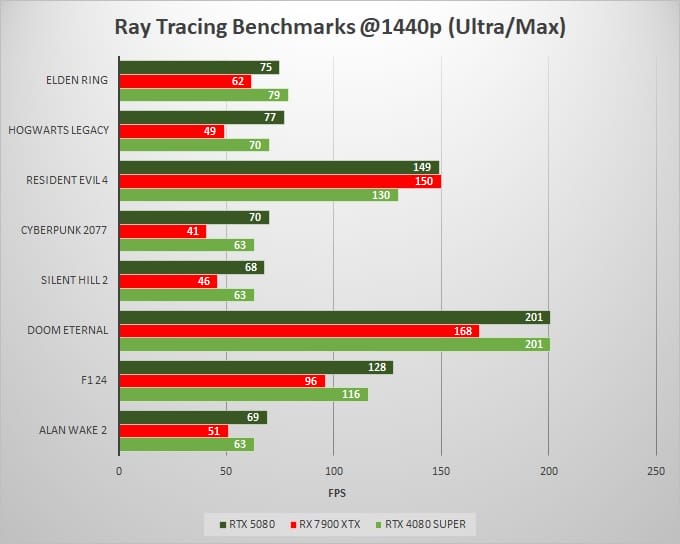
In Ray Tracing, the RTX 5080 is around 7 percent faster than the RTX 4080 SUPER and 34 percent faster than the RX 7900 XTX.
Power Consumption
RTX 5080 has a maximum power consumption of 360W and needs a 750W or higher PSU. RTX 4080 SUPER power consumption is 320W and needs a 750W power supply. RX 7900 XTX’s maximum power consumption is 355W and requires 800W or better power supply. For power, RTX 5080 and RTX 4080 SUPER use a single 16-pin 12VHPWR connector, while the RX 7900 XTX uses two 8-pin PCIe connectors from the power supply.
| RTX 5080 | RX 7900 XTX | RTX 4080 SUPER | |
| Power Connector | 16-pin 12V-2×6 HPWR | 8-pin PCIe (x 2) | 16-pin 12VHPWR |
| Power Consumption | 360W | 355W | 320W |
| Recommended PSU | 750W | 800W | 750W |
Pricing & Availability
The official MSRP for all three of these cards is the same, which is 999 USD. However, the custom models of these cards from different AIB partners cost more, and you can check the latest prices from the links below.
Check RTX 5080 Price on Amazon
Check RTX 4080 SUPER Price on Amazon
Check RX 7900 XTX Price on Amazon
RTX 5080 vs RX 7900 XTX vs RTX 4080 SUPER Specifications
| RTX 5080 | RX 7900 XTX | RTX 4080 SUPER | |
| GPU Chip | GB203 | Navi 31 | AD103 |
| GPU Architecture | Blackwell | RDNA 3 | Ada Lovelace |
| Fabrication Process | 5nm | 5nm | 5nm |
| CUDA Cores/Stream Processors | 10752 CUDA Cores | 6144 Stream Processors | 9725 CUDA Cores |
| Ray Tracing Cores | 84 (4th Generation) | 96 | 76 (3rd Generation) |
| Tensor Cores | 336 (5th Generation) | 192 | 304 (4th Generation) |
| Memory Size | 16 GB GDDR7 | 24 GB GDDR6 | 16 GB GDDR6X |
| Memory Interface | 256-bit | 384-bit | 256-bit |
| Memory Speed | 30 Gbps | 20 Gbps | 22.4 Gbps |
| Memory Bandwidth | 960 GB/s | 960 GB/s | 717 GB/s |
| Bus Interface | PCI Express 5.0 | PCI Express 4.0 | PCI Express 4.0 |
| DirectX | 12 Ultimate | 12 Ultimate | 12 Ultimate |
| OpenGL | 4.6 | 4.6 | 4.6 |
| Vulkan | 1.4 | 1.3 | 1.3 |
| SLI / CrossFire | NA | NA | NA |
| VR Ready | Yes | Yes | Yes |
| G-Sync/FreeSync | Yes | Yes | Yes |
| Power Consumption | 360W | 355W | 320W |
| Recommended PSU | 750W | 800W | 750W |
See also:
Final Words
RTX 5080 is no doubt a very good card with all the latest technology, but when it comes to raw performance, it does not offer a significant boost over the RTX 4080 SUPER or the RX 7900 XTX. Moreover, the power consumption and price of all three cards are almost identical. However, RTX 5080 supports newer technologies and display output ports, giving it an edge over its competitors. If you want to share your thoughts on this comparison, please let me know in the comment section below.
(*This post may contain affiliate links, which means I may receive a small commission if you choose to purchase through the links I provide (at no extra cost to you). Thank you for supporting the work I put into this site!)
![Best RTX 4070 Ti Cards for 1440p & 4K Gaming [Custom Models] Best RTX 4070 Ti Cards for 1440p & 4K Gaming [Custom Models]](https://graphicscardhub.com/wp-content/uploads/2023/01/PNY-GeForce-RTX-4070-Ti-12GB-OC-XLR8-Gaming-Verto-TF-211x150.jpg)
